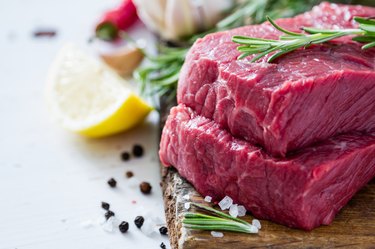
A rump roast doesn't have much fat, but the little fat it does have offers much- needed moisture and flavor. Rump roast is so lean that it's often larded with extra fat in restaurants. Cook it with the fat side up so the juices can melt and penetrate the meat, similar to basting a turkey or chicken as it roasts.
Lean Rump Roast
Video of the Day
Rump roast, also known as bottom round, comes from the upper back leg of the steer. This roast is naturally lean, but somewhat tough. It doesn't contain a lot of marbling or much surface fat, and requires long slow cooking to melt the connective tissue in it and tenderize it. Use what little fat it has to your advantage.
Video of the Day
Fat on Top
In most cases, you should cook a rump roast with the fat side up. As the roast cooks, the fat melts and runs down the sides of the meat to baste it and provide flavor and moisture. If the fat is sitting on the bottom of the pan, you won't get the same benefit. For a leaner dish, trim the fat off before cooking or place the roast with the fat in the bottom of the pan. Keep in mind, however, that the roast may be drier and less flavorful.
Into the Oven
How you cook a rump roast is as critical as where the fat is positioned in the pan. Braising a rump roast in liquid gives consistently moist, juicy, flavorful results. Start by browning the roast in a bit of oil on the stovetop to seal in juices and create a golden-brown crust. Add enough liquid, such as red wine, beer, beef broth or juice, to partially cover the roast. Place the lid on the pan and slow cook the roast in an oven set to 300 degrees Fahrenheit for two to three hours, or until the roast is fork tender and a meat thermometer inserted in the roast registers 180 to 190 degrees Fahrenheit. Remove the roast from the oven and allow it to rest in a draft-free spot for 20 minute before you slice it.
Thinking Ahead
Rump roast is a fairly straightforward cut of meat, but a few extra steps can make a big difference in flavor and texture. When choosing a rump roast, select one that has a bit of marbling and fat. Unwrap the meat and salt it a day ahead. Rewrap the roast and refrigerate it. Salting helps tenderize the meat and gives it flavor -- an important consideration when using a lean piece of meat such as rump roast. Allow the roast to come to room temperature for better browning. Finally, braise it in a heavy, lidded pot or roast it in a roasting pan.